The tastes of charcuterie vary greatly; I will describe all categories I have eaten, researched, judged, taught, and made at home.
Traditional salumi or charcuterie, like cold smoked meats and dry cured meats, have a high level of ‘umami,’ a balanced ‘savory’ flavor. Many cured types of meat, such as prosciutto and pancetta, use salt to preserve; they are cut wafer thin, so the salt is subtle. Fat melts in the mouth.
There are many types of charcuterie, with many variations that can have completely different flavor angles.
| Charcuterie Category | Taste Description |
|---|---|
| Dry Cured Meats | Juicy from pork fat (depending on how dry dryness) – Tangy if fermented (subtle in some salamis). Maybe slightly sweet, very moorish |
| Dry Cured Salami | Juicy from pork (or other meats) fat (depending on how dry ) – Tangy if fermented (subtle in some salamis). Maybe slightly sweet, very Moorish |
| Fresh Sausages | Varies widely based on recipe and spices – Background juicy flavor – Moist when cooked, Poultry, Red Meat, Game Meat, Fish – thousands of recipes |
| Pates | Creamy and rich – Buttery in the mouth – Deep dark umami flavors – ‘Gamey’ wild-type flavor from offal often |
| Rillettes & Confit | Rich and soft – Creamy and buttery – Umami – Oily (depends on the recipe) |
| Bacon | Porky and pink (from nitrates) – Salty and sweet – Smoky and rich. Other meats are sometimes used. |
| Pancetta | Soft, melting in the mouth – Salt-balanced and rich – Balanced spices and buttery |
| Cold Smoked Meats | Smoky and a little salty – Deep and dark meat flavors – Saltiness varies based on saturation point during preservation. Sugar/Sweetness is often added to bacon |
| Hot Smoked Meats | Smoked Ham Popular – porky, salt and sweet. Taste varies based on technique and wood used. Salt, Sweet and Smoke Flavors, Bacon can be Hot Smoked (sometimes this is why people say the bacon tastes like ham – I wrote about the difference here) as well. |
I will explore all categories below.
Dry cured and smoked meats are probably the cornerstone of charcuterie in the modern interpretation, but I also want to cover what charcuterie is from the traditional French interpretations.
Whether you want to make cured meats or get an idea of their taste.
This page should hopefully give you a better idea. But remember to be open-minded because it’s an ancient art, cold smoking and dry-curing meat goes back thousands of years for classic Italian styles, and much deeper into history for salt-preserved meats.
Most types of fish when I was a kid I didn’t like. As I got older (and more open-minded), my passion in my young adult years started to focus on smoking and curing meats. I find the whole idea of new flavor angles and preserving very exciting.
I’ve been lucky enough to try cured meats worldwide, and charcuterie is an ever-expanding category that crosses cultural ideas and barriers; this is happening all the time.
Although Europe loves to keep to its traditional styles that have developed over hundreds or even thousands of years.
Prosciutto goes back to the Roman Empire; more on the history of the craft and art style dry cured meat here.
The Taste of Charcuterie
I will describe the flavors of the main types of charcuterie in this list.
- Dry Curing Meats
- Fresh Sausages
- Pates & Rillettes
- Bacon & Pancetta
- Cold Smoked Meats
- Hot Smoked Meats
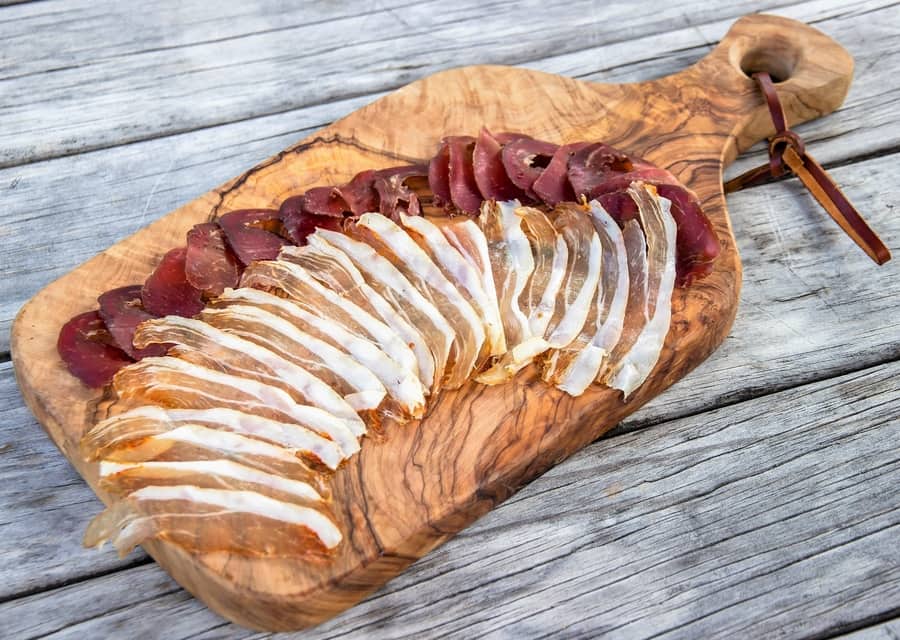
Dry Cured Salami
Most dry-cured salami (I wrote about different salami ideas also for pizza types) I’ve come across these days has some kind of tangy taste; the reason for this is that the salami quite often has been fermented at the start of the process at the beginning.
This tangy or acidic flavor has different flavors, which you can choose from to give different flavor angles with salami.
Many salamis are cold smoked, but not all are, leading to another flavor angle.
When describing salami’s taste (I wrote in detail about the unique taste of salami here), I’m talking about quality crafted products that people care about and have put some passion into. Some of the factory food style supermarket salami might not quite have this level of complexity, at the end of the day corporate large supermarket food chain is generally about profit, not taste or passion. (opinion)
Words to describe – the taste of dry-cured salami
- juicy to from the pork fat (depending on how dry it is, though)
- tangy – very subtle in some salami
- whole peppercorns – common – pepper spicy
- maybe a slight sweetness from the meat
- Many salami have a light garlic flavor
Fresh Sausages
There are probably hundreds of thousands of variations of sausage flavors.
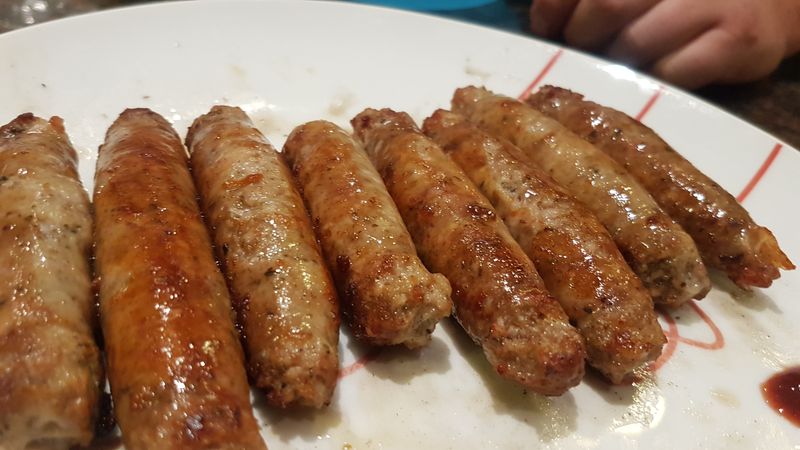
Every recipe I’ve come across for sausages always has around 15 to 30% pork fat (same with salami generally). This gives the background a juicy flavor, and when you cook the sausage, it stays moist (or should unless you overcook it).
There are sausages made out of just about any meat in the world; this one really does vary and depends on where and what. But since you usually use meat plus salt and spices, it all depends on what the spices are.
German and Eastern European sausages are a must-try with white pepper & green spices in Central Europe or amazing paprika flavors of the East.

Emulsified sausages are often of poor quality since the uniform textures allow commercial producers to hide the ‘fillers’ that are often non-meat based like ‘bread crumbs.’ They also allow the sausage to bind with water, making the emulsified sausage more profitable.
Hot dogs, spam, baloney, and wieners are often these types.
Italian Mortadella is a quality style of emulsification.

Pates & Rillettes
With pates, it’s mainly around some form of liver or other offal; a bitter, dark savoriness comes from offal. It’s a pity it’s fallen out of favor in many Western countries.
Since there is such a rich amount of nutrients from a small animal liver.
Words to describe Taste of Pates
- Creamy and rich
- Buttery in the mouth
- Deep, dark umami flavors
- ‘Gamey’ wild-type flavor from the offal
Most rillettes are generally preserved meat in a type of animal fat. Being rich makes it always best to use a small amount. The meat is cooked and then packed in a jar of fat.
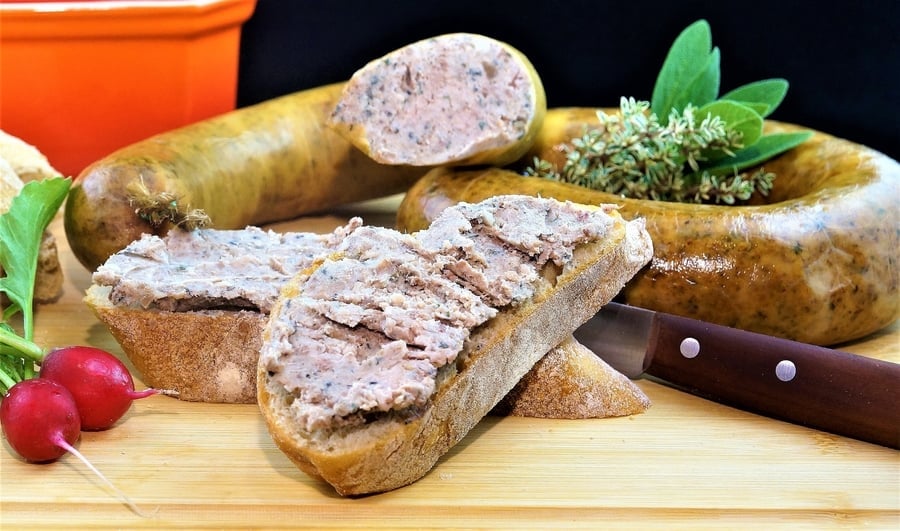
Again, the different spices that are added can change the flavors.
Words to describe the taste of rillettes & confits
- Rich and soft
- Creamy & buttery
- Umami of course
- Oily sometimes
(it does depend on the recipe, of course)
Bacon & Pancetta – The Difference and Flavor
Bacon has a porky flavor; people don’t realize that there is a flavor profile.
A lot of commercial bacon has a significant aspect of salt and sugar; there’s something that people have become accustomed to with bacon (i.e. maple-cured bacon), sugar-cured bacon, etc.
The bacon is often finished with cold, liquid, or hot smoke, which gives it that delicious finish.
I’ve made all sorts of bacon, such as ‘whiskey cured bacon’ and soft and hard green herb bacon – there are endless possibilities.
Words to describe – Taste of Bacon
- Porky and pink (pink is from the Nitrates, too)
- Salty and sweet -sherbert flavor (for most store-bought bacon)
- Smoky and rich
Pancetta
Pancetta is a classic Italian dry-cured and spiced pork belly. It has a lot of that savory umami flavor because it’s dry-cured until it’s lost enough weight. Like most dry-cured meats, the flavor intensifies with all the spices and is often eaten without cooking.

Words to describe – taste of pancetta
- Soft and melting in your mouth
- Salt-balanced and rich
- Balanced spices and buttery
Cold Smoked Meats
Cold smoking does change things a lot, but people don’t realize that cold smoked meats are just dry-cured meats with smoke added during the drying process. So cold smoked meat isn’t cooked, it’s dried until preserved via cold smoke kind of like jerky or biltong.
Classic cold smoked salmon is a perfect umami pairing; the type of wood you use can change the flavor of the salmon quite a lot as well. But most store-bought bacon won’t stipulate the wood, handcrafted bacon will maybe.
And it is quite a salty product that needs to be thinly sliced. Any cold-smoked meat will generally have a well-seasoned saltiness because it has to have the salt to preserve it to a certain saturation point.
However, for at-home meat curing and smoking, there are ways of ‘choosing’ the level of saltiness.
Words to describe the taste of cold smoke meat
- smoking & a little (hopefully) salty,
- deep and dark meat flavors
(Then it depends on the meat and the spices; there are so many variations across Europe – cold smoking is such a massive topic both in people’s homes and commercially)
Hot Smoked Meats
Low and slow smoking is hot smoked, but it’s taken on a certain angle with the barbecue-smoked community.
Hot smoking is significant in the United Kingdom, where it’s common to hot smoked salmon or trout in a more direct heat-type way, like a portable smoker.
It’s also a common way bacon is made in America, hot smoking is a lot more common then cold smoking.
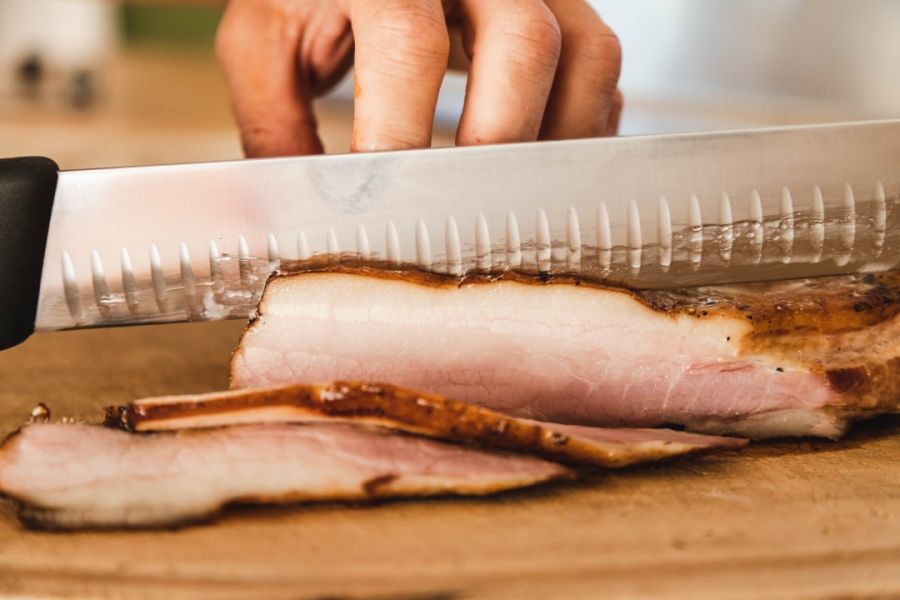
Europe, especially Central and Eastern Europe, has many unique traditional styles of hot smoked meats.
Hot smoking is cooking the meat whilst also generating some smoke.
Taste of hot smoked meat
- Smoky but more subtle sometimes
- Not salty like cold smoked goods
The type of technique and the wood used can ultimately vary the taste!
It’s a good idea to go over some of the everyday things about them.
Have you heard of Umami? Dry Cured Meats Nails It
“Savoriness” – in a nutshell, pretty much.
Along with the other significant tastes like sweetness, sourness, and bitterness. There is another flavor that doesn’t get mentioned as much.
That is umami, which is the taste of savory flavors. To give you some examples like,
Anchovies, Mushrooms, Parmesan, Kimchi, Seafood.
And they say the most umami-flavored vegetable is the mighty red tomato.
Here is a link to a page all about Umami – on the heathline website.
A Quick Overview Modern vs Traditional Charcuterie
Modern Charcuterie
The modern interpretation of charcuterie (salami is part of it; I wrote a little more on that here) is all those above categories, which I’ll dive into next. It also probably covers anything you would put on a charcuterie board nowadays.
Although charcuterie boards will generally always focus on dry-cured meats or salamis, they seem to be the show’s highlights on most of the boards I have eaten.
So charcuterie board (here is what to do with leftover charcuterie meats) condiments also include cheeses, bread, spreads like pesto or beetroot-based spreads, crackers, nuts, pickles, and chutney – pretty much anything with a savory flavor belongs on a charcuterie board.
Then, some types of fruit that match the meat are my favorites, like melon or strawberry.
Traditional charcuterie
Charcuterie is a French word, and the classic interpretation includes dry-cured French salami, offal meat goods, rillettes, and pates.
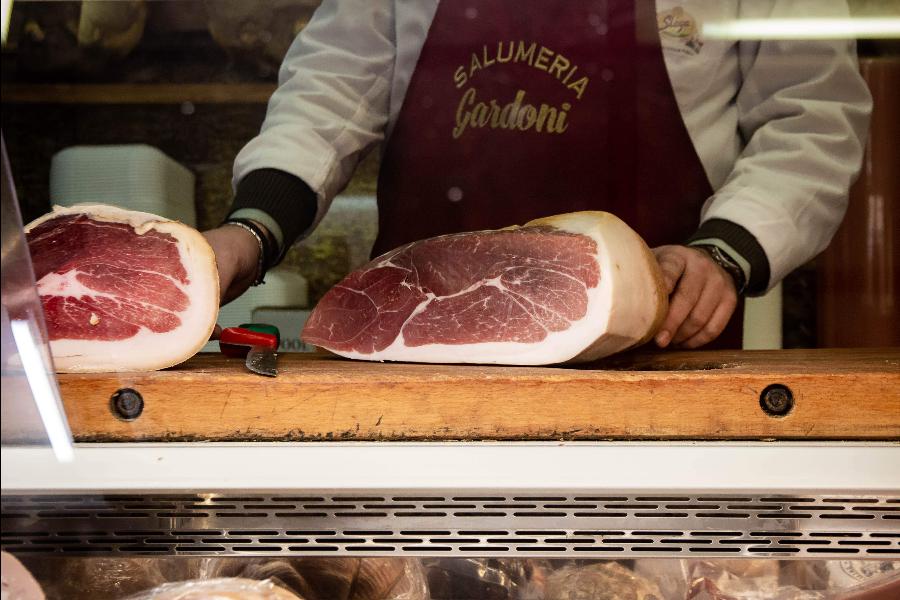
Dry Cured Meats
- Parma Ham / Jamon Iberian Ham
- Prosciutto
- Lonza
- Braesola
These are the cornerstone of salumi and charcuterie – salt dry-cured meat, dried out enough to perfectly intensify the flavor and preserve it for the long term.
Umami, savory is the key to a lot of these dry-cured meats when sliced wafer-thin – because they have been salt-cured., when they are cut translucently thin, there is a balance between the amount of salt seasoning and the meat flavor.
I went to Montenegro and found that their salt-cured prosciutto and other dry-cured meats were too salty. Interestingly enough, they generally cut the meat quite thick (like 2-3mm- yes, that is thick for dry-cured beef), but they may have always used large amounts of bread or something to balance the flavor.
Words to describe the taste of dry-cured meats
- meaty
- soft
- balanced seasoning
- fat melts typically in the mouth, buttery flavor
- porky but not like bacon (if it is a pork)
The Italians have popularized many of the dry-cured meats of the world, and it goes back to Roman times. It’s crazy that nowadays, Parma Ham is still just pork and salt (more on this later).
But the taste is something else; a flavor develops when the meat is of excellent quality and the pigs have had a good life and have been fed well.
Parma Ham comes from, of course, Parma, Italy (it has too to be called Parma Ham, internationally protected), where Parmesan cheese comes from. The leftovers from producing the cheese are called the whey. They are fed to the Parma ham pigs, giving them a distinctive flavor.
(Jamon Iberian Dry Cured Ham, the pigs are finished on acorns nuts)
Some classic dry-cured meats are called Italian salumi, the seven major muscle groups where the pig gets butchered and chopped up. Some are very simply spiced, and some have a bit more pungency.
Like coppa, which has the spice blend of juniper berries, peppercorns, and thyme.
What Does Bacon Taste like?
Great bacon is slightly salty, sweet, smoky and rich with fat.
What Pate Made Of?
Often many types of offal like liver are used, fat of some kind also creates the richness of the spread with accompany herbs and spices.
What Create Great Tasting Dry Cured Meats?
The length of time drying intendifies flavors, has some acidic/fermentation aspects and breakdown the meat to be soft and subtle. Time is the key to create dry salt cured meats.
Feel free to reach out and leave a comment, I’m always looking for comments of any form.

Tom Mueller
For decades, immersed in studying, working, learning, and teaching the craft of meat curing, sharing the passion and showcasing the world of charcuterie and smoked meat. Read More
